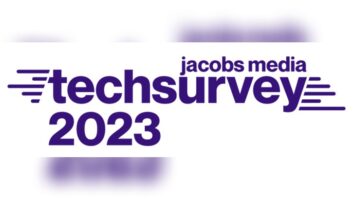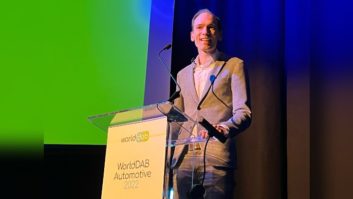The author is senior director, cloud and infrastructure solutions for Lawo.
We all know that the reports of radio’s gradual demise are greatly exaggerated. Radio is gearing up for an even brighter future. Three trends will play an important part in this. They are IP and cloud technologies; remote production; and the flexibility to serve additional channels and platforms.
Remote production has become a powerful tool for creating content from just about anywhere. While certain shows call for an OB or remote van loaded with all the equipment you may (or may not) need at some point, operators increasingly focus on the absolute minimum in terms of size and weight, and on equipment that is simple to set up and operate. Nineteen-inch, carry-on “flypacks” are preferred.
Also think of the radio-in-a-bag initiative: A laptop with intuitive yet versatile radio software, an I/O box, one or two microphones and a pair of headphones are all you need to produce high-quality radio shows on the go. This works over an IP connection, whether tethered or via 4G.
Yet, software that runs off a laptop’s hard disk forces operators to consistently use the same computer. A cloud-based solution would provide more flexibility. Streaming the contents to the broadcasting hub requires an IP connection anyway, so leveraging cloud-based software over the same connection should be reliable.
The acceptance of IP has inspired new workflows: Radio hosts present their shows from their homes, while a field reporter or technician facilitates interviews with guests in a different location, perhaps only holding a microphone to the guest’s mouth, with the host asking questions.

Adding social media channels and instant messaging services makes for even more interactive radio shows. Producing more such “multi-platform” content to keep both staple and alternative channels humming has become easier and certainly more convenient for all parties.
Flexibility
Demand for more flexible systems spans the industry. At last year’s NAB Show, the European Broadcasting Union published a white paper that emphasizes the need for a broader utilization of cloud technologies. “Cloud” doesn’t necessarily refer to the public cloud. A centralized datacenter to which users connect over wide-area IP is often called a private cloud.
The white paper does not mention specific segments of our industry where flexibility is deemed crucial: the agility to adapt to changing production scenarios at short notice is expected everywhere.
Radio has come a long way. One inspiring example is an essentially hardware-free, virtualized radio workflow: RTL Belgium’s Magenta project removes all clutter typical of traditional radio studios by simplifying operations and minimizing distractions for self-op radio hosts and DJs. Based on software-driven touchscreen operation with far-reaching automation routines that can be overridden when needed, the virtual infrastructure in Brussels serves two top-tier Belgian radio stations, bel RTL and Radio Contact, which use the same studios.
Radio hosts and DJs log into their preferred studio via an on-screen “Magenta Menu” where they select the station they work for. The menu then branches out into different applications, such as live on-air production, show recording, etc.

Pressing one of the two station buttons — BEL RTL or CONTACT — automatically adapts the visual elements and ambient lighting color (for visual radio) to the selected station. In parallel, the studio connects to the correct playout server and loads the relevant rundown and other radio tools.
All aspects have been automated to such a degree that RTL Belgium no longer needs an audio engineer in a separate control room for morning shows and other programs involving up to 12 attendees in a large studio. There is only one control room for a “director” in charge of seamless production flows — getting the required guests into, and out of, the studio on time, etc. — rather than monitoring and tweaking levels, starting clips and jingles, and the like.
Levels are controlled automatically by dedicated software, and nothing needs to be set by the hosts, unless they decide to override the automated rundown for some breaking news or other top-topical subjects.
Installing hardware in the refurbished studios was deemed too restrictive for RTL’s vision to further refine the current workflows at short notice. The Magenta project allows the team to increase the system’s flexibility and revise workflows at any time. Airing the radio program on RTL Belgium’s TV channels is made easy by the IP connection between the two departments.
All radio tools are software-based. The VSM control system glues everything together, powers the Magenta menu for automated, single-press studio and playout configuration by the hosts themselves, etc. Thanks to this approach, radio hosts can literally “take their settings with them.”
The VisTool app controls the I/O nodes and simultaneously hosts the Pluxbox user interface, which provides operators with the functionality needed to run a radio show.
The operator-facing user interface developed by Pluxbox controls the OmniPlayer playout system. The Magenta project is a light-house example of the efficiency afforded by open-standards-based IP and tight software integration for user-friendly, inspiring workflows. Getting there, however, was hard work.
Moving on
The tools that link the various software applications and the I/O hardware together, and the Ravenna/AES67 protocol to get any signal source to any destination are thus in place. But what if an even more flexible approach was available?
Imagine yourself planning for a major infrastructure overhaul. You probably have a good understanding of what the setup must provide for day-to-day productions. You also know that certain events require more extensive coverage, with more reporters and tools.
In the hardware world, this would mean planning for such special occasions, and so to order more equipment, just in case. Such excess gear sits idle most of the time, which tends to make your head of finance unhappy.

For TV applications, microservice-based processing apps are becoming the new normal. They run on generic servers in the private or public cloud, or in-house, and can be started and stopped as needed. While they are stopped, the server’s processing capacity can be used for other tasks, which results in a drastic reduction of the hardware stack.
These apps are true container-based microservices, each with a highly specific function related to audio, video or audio mixing and monitoring with powerful N–1 functions. Their virtual inputs and outputs are separate, highly granular microservices that can be connected to the processing routines. They are granular in that you can easily specify the required number of I/Os, the transcoding format or up/down/cross conversion functionality, without overspec’ing.
In combination with a subscription scheme based on credits, users are free to reconfigure their entire setup several times a day. Active credits do not disappear when an app is stopped — they become available for unlocking other functional units. Everything is so intuitive that stations can focus on hiring genuine talent rather than technicians with a good voice. Are you ready?







